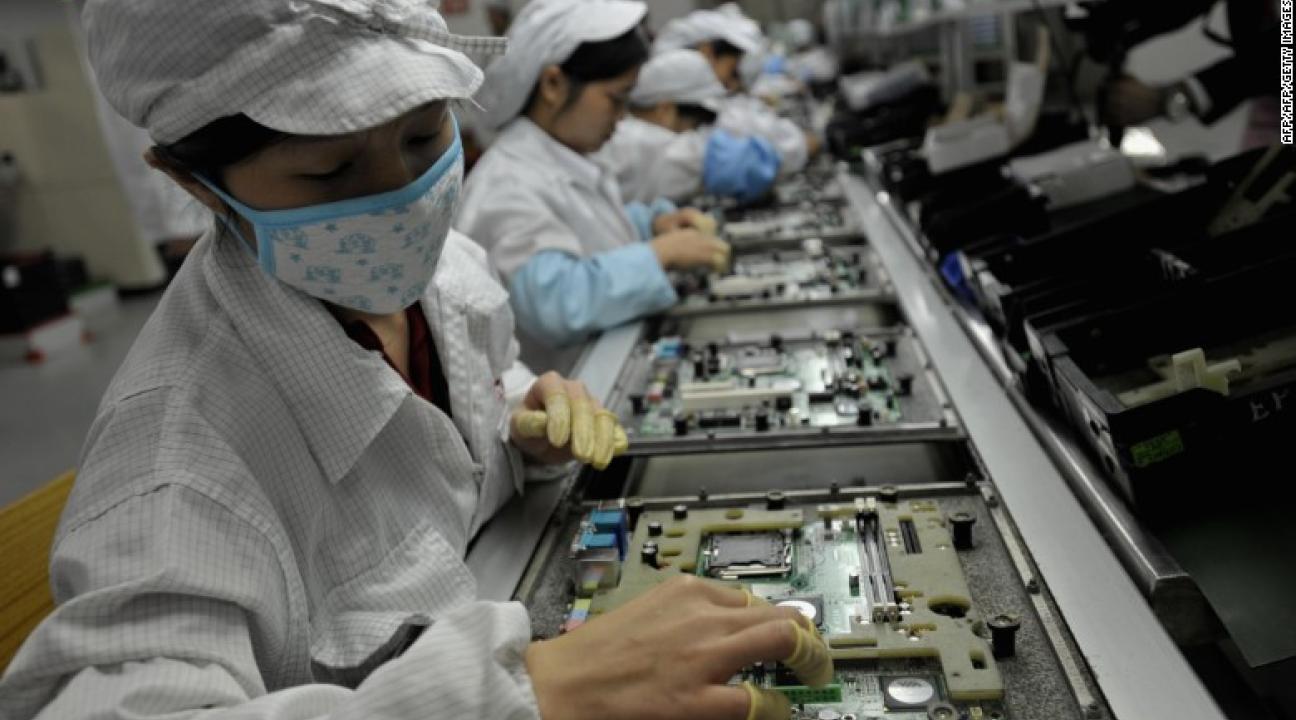The Life of an iPhone
This is second in a three part series. See Part 1: The Life of Lettuce.
The influence and reputation of the Apple empire is undeniable, and the demand for their most famous product, the iPhone, increases with every updated model. While iPhones continue to be mass produced and purchased hot off the press, as consumers what do we really know about these devices besides the convenience they bring to our lives? What about the vast amount of resources that go into the creation of these phones, such as fossil fuels, mined minerals, and human-labor? Perhaps if we truly knew the costs of what it takes to produce an iPhone, we all wouldn't be so keen on buying the newest version as soon as it is released. In this blog post, we will explore all the steps necessary in order to create an iPhone, and how you can be a conscious consumer when it comes to technology.
Click below to see the graphic for a condensed version of "The Life of an iPhone", and a further explanation of some tips to keep in mind as a consumer!
So where does the creation of an iPhone begin?
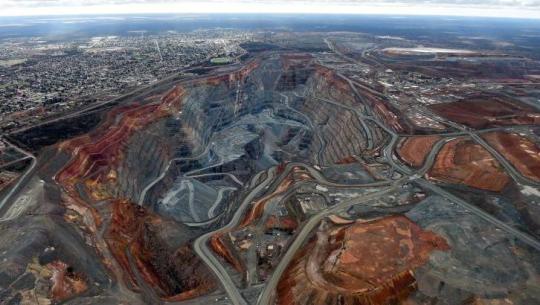
1. The mining and acquisition of precious raw and rare Earth minerals
Mining -When we are holding the incredibly device in our hand, it is easy to forget what exactly it is made of. As it turns out, an iPhone requires a variety of minerals such as gold and copper, from around the world, including China, South Africa, and Chile, to create. [1]Unfortunately many of these raw and rare minerals can only be found buried deep underground in layer of the Earth. Mining corporations dig up thousands of tons of ore, a metal-bearing mineral or rock, in order to extract these desired minerals. [2] To excavate these minerals not only requires substantial, expensive equipment and hours of manpower, but also takes a devastating toll on the surrounding environment and landscape. A common method for excavating minerals and other natural resources is mountaintop removal, which has quite the track-record of environmental damage including water pollution, deforestation, habitat destruction, and soil instability. Areas that were once covered in vegetation and teeming with wildlife become uninhabitable and stripped of their natural features. [3]Mining can also have social consequences for the communities in which it is performed including pollution, health effects, emigration, and economic dependence on the industry to support the local workforce.
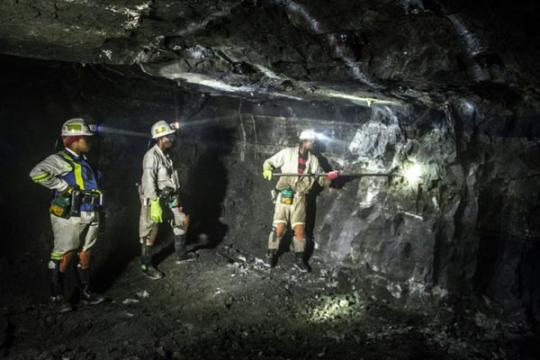
Extraction - The ore is always mixed with unwanted or valueless rocks and minerals. Once they are collectively taken out of the host rock in a mass by either mechanical or manual means, the ore is separated by various operations known collectively as mineral processing, or ore dressing. The desired metallic element is then extracted from the ore by various smelting, roasting, or leaching processes. Fortunately, recent advances in hydrometallurgy allow for some metals including copper, uranium, and gold to be removed from the host rock without drilling and blasting. [4]
Transportation - Because the necessary minerals are only found in certain countries, they need to transported to the to the various manufacturing partners of Apple around the world by vehicle, plane, or ship, primarily relying on fossil fuels to make this transportation possible. [5]

2. Manufacturing of the individual components
Global effort - The finished iPhone that you hold in your hand is actually made up of an impressive amount of individual, working parts. The manufacturers responsible for creating the iconic components of the iPhone such as the battery, the camera, the glass screen, and the touchscreen controller, are located in Germany, South Korea, Japan, Brazil, Poland, Italy, Malaysia, the United Arab Emirates, and various other countries. [6] In addition to the commonly-known minerals, such as gold, copper, or silver, used in an iPhone, the individual phone features also require a variety of rare earth minerals, 90% of which are mined in China. For example, the color screen is made up of the seldomly mentioned minerals yttrium, lanthanum, praseodymium, europium, gadolinium, terbium, and dysprosium. [7] The phone's speakers, circuitry, and vibration unit also share the need for some of these materials. If you already thought that iPhones were complicated, understanding the complexity of the basic makeup of these devices is enough to confuse any consumer. After the individual components of the iPhone are complete, they are all transported to China where Apple's factories are located.

3. Assembling the iPhone
Labor - At the iPhone factories, Chinese and Taiwanese workers assemble the separate components into millions of iPhones. When it comes to the cost of labor for each iPhone there is no clear answer, but the average estimate is somewhere around $2 an hour, making the total pay for the 17 hours of labor needed to build the final product around $30. [8] Discussions and speculations about the feasibility of moving the manufacturing or assembly of iPhone parts to the U.S. agree that the device would then cost significantly more. The Massachusetts Institute of Technology, a well respected voice in the tech world, estimates that if the assemblage of the phone was performed in America the individual price would be raised by $30 to $40. Additionally, if Apple were to transfer its component manufacturing here, the cost of the iPhone would increase by $100, leading to an overall cost closer to $900.[9] Perhaps if it did cost this much, we would be more inclined to recognize that an iPhone is much more of an investment (and piece of technology) than just a regular cell phone.
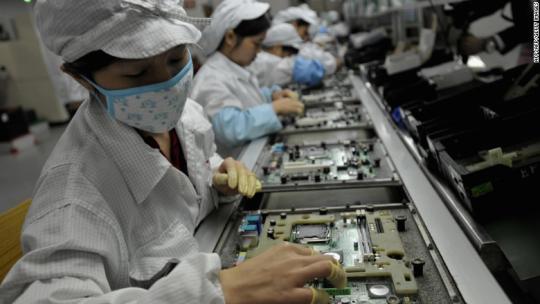
4. Packaging and shipping
Quality packaging - If you have ever purchased a brand-new iPhone, you have probably noticed the incredibly durable and luxurious packaging your device comes in. Unfortunately, these unnecessarily crafted boxes are created using a variety of materials and resources, despite the fact that many people throw them away without hesitation. The bottom of the box in made from a double reinforced cardboard with a plastic tray insert which holds the iPhone, while the top only requires a single layer of cardboard. The "cardboard" itself is a thick fiberboard, and the plastic used in the packaging is polystyrene. The thinner, flexible plastic components are most likely low density or linear low density polyethylene. The final touch to these boxes that gives them the signature Apple look is the matte-lacquer/matte-laminate that gives it a smooth and expensive feel. [10] As you can see, it takes quite a lot of work and materials, in order to produce packaging that will likely end up in the trash.
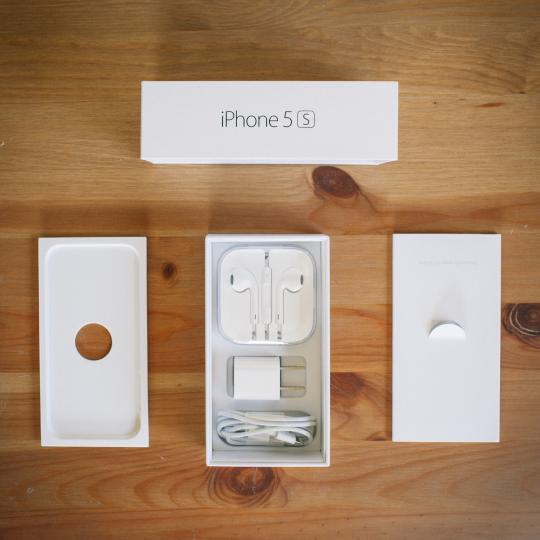
Transportation - In 2014, over the span of just a quarter of a year, Apple shipped 30 million phones to North America, and it is likely that today that number is even higher. When shipping such a large number of products overseas, it is important to weigh your transportation options for the most cost-effective and time-effective result. An estimated 44,000 iPhones can fit into one standard 40 foot shipping container, and based on market prices and Apple's massive purchasing scale we can assume it costs about $3,000 per container. Including trucking, customs clearance on both sides, terminal fees, fuel surcharges and everything else it works out to be about $0.07 per phone. In general, air freight is between 5x - 10x more expensive than ocean freight. However, it takes only 3-5 days for iPhones on air freight to reach their final destination in Apple's retail stores, versus 30 days or more just to cross the Pacific by ship. [11] Though using air freight is significantly more expensive, the amount of time saved by flying is worth the cost for Apple.
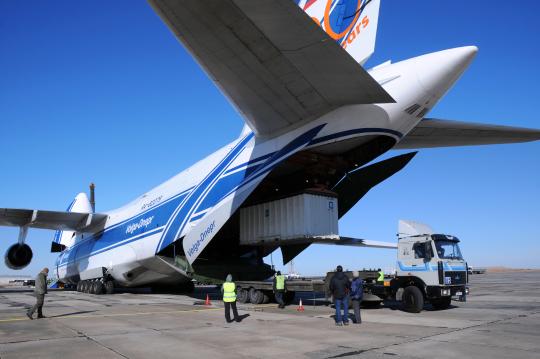
5. Pricing and sale
Profit margin - It's worth noting that Apple makes a far greater profit from their product than any other phone manufacturer. For each iPhone, Apple manages to pocket close to $300, which is a profit margin of almost 50 percent. [12] However, this impressive profit isn't unheard of for other highly successful companies. For example, Nike's gross profit margin is about 43 percent, and Levi Jeans reports a 52 percent gross margin. When it comes to the food industry, it may or may not come as a surprise that fast food franchises lead the game in profit. McDonald's gross profit is about 40 percent, while Burger King makes around 56 percent. [13] That means that these chains are actually making a profit, a quite large profit in fact, from their $1 hamburgers... The iPhone may be expensive, but we overpay for a lot of products these days. We need to ask ourselves as consumers, are the products we buy worth the money we pay for them? What are the true costs of the materials used to produce these items, not just financially but also socially, economically, and environmentally?
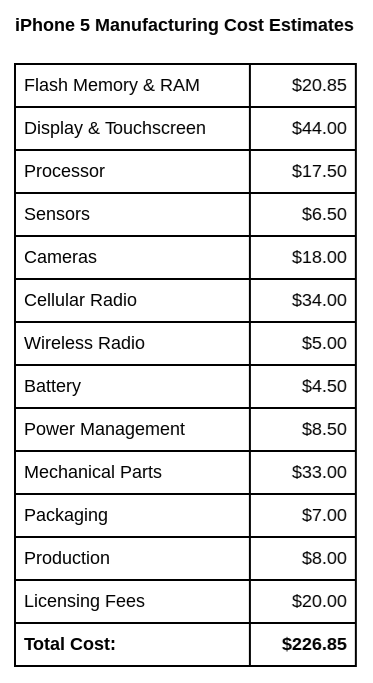
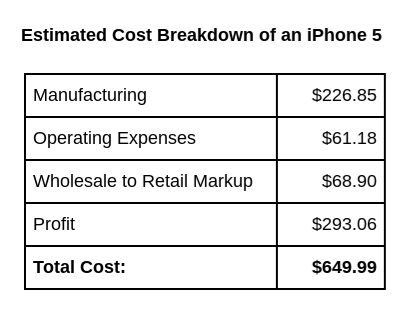
6. What can you do now?
Now that we have reviewed all the steps that go into creating an iPhone, as well as the real cost of its production around the world, you have the opportunity to make a positive impact as a consumer. iPhones and smart phone technology are not going anywhere, so here are some tips to keep in mind during the lifespan of your mobile and electronic devices:
- Use your phone until it doesn't work anymore
- Resist unnecessary upgrades
- Always recycle your old electronics
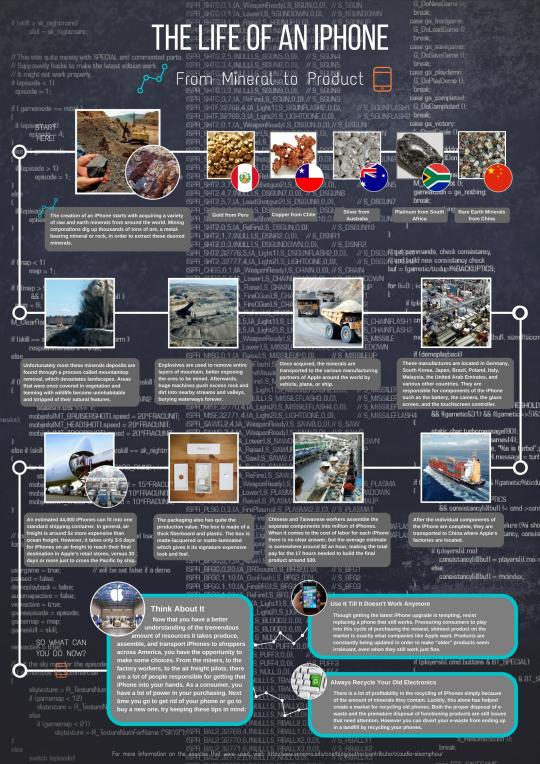
"The Life of an iPhone" Infographic - From Mineral to Product
1. The creation of an iPhone starts with acquiring a variety of raw and earth minerals from around the world. Mining corporations dig up thousands of tons of ore, a metal-bearing mineral or rock, in order to extract these desired minerals.
- Gold from Peru
- Copper from Chile
- Silver from Australia
- Platinum from South Africa
- Rare Earth minerals from China
2. Unfortunately most these minerals deposits are found through a process called mountaintop removal, which devastates landscapes. Areas that were once covered in vegetation and teeming with wildlife become uninhabitable and stripped of their natural features.
3. Explosives are used to remove entire layers of mountain, better exposing the ores to be mined. Afterwards, huge machines push excess rock and dirt into nearby streams and valleys, burying waterways forever.
4. Once acquired, the minerals are transported to the various manufacturing partners of Apple around the world by vehicle, plane, or ship.
5. These manufactures are located in Germany, South Korea, Japan, Brazil, Poland, Italy, Malaysia, the United Arab Emirates, and various other countries. They are responsible for components of the iPhone such as the battery, the camera, the glass screen, and the touchscreen controller.
6. After the individual components of the iPhone are complete, they are transported to China where Apple's factories are located.
7. Chinese and Taiwanese workers assemble the separate components into millions of iPhones. When it comes to the cost of labor for each iPhone there is no clear answer, but the average estimate is somewhere around $2 an hour, making the total pay for the 17 hours needed to build the final product around $30.
8. The packaging also has quite the production value. The box is made of a thick fiberboard and plastic. The box is matte-lacquered or matte-laminated which gives it its signature expensive look and feel.
9. An estimated 44,000 iPhones can fit into one standard shipping container. In general, air freight is around 5x more expensive than ocean freight. However, it takes only 3-5 days for iPhones on air freight to reach their final destination in Apple's retail stores, versus 30 days or more just to cross the Pacific by ship.
Think About It
Now that you have a better understanding of the tremendous amount of resources it takes produce, assemble, and transport iPhones to shoppers across America, you have the opportunity to make some choices. From the miners, to the factory workers, to the air freight pilots, there are a lot of people responsible for getting that iPhone into your hands. As a consumer, you have a lot of power in your purchasing. Next time you go to get rid of your phone or go to buy a new one, try keeping these tips in mind:
Use It Till It Doesn't Work Anymore
-Though getting the latest iPhone upgrade is tempting, resist replacing a phone that still works. Pressuring consumers to play into this cycle of purchasing the newest, shiniest product on the market is exactly what companies like Apple want. Products are constantly being updated in order to make "older" products seem obsolete, even when they still work just fine.
Always Recycle Your Old Electronics
-There is a lot of profitability in the recycling of iPhones simply because of the amount of minerals they contain. Luckily, this alone has helped create a market for recycling old phones. Both the proper disposal of e-waste and the premature disposal of functioning products are still issues that need attention. However you can divert your e-waste from ending up in a landfill by recycling your phone.
Footnotes
1. https://www.valuewalk.com/2013/04/raw-materials-used-in-iphone-infographics/
2. https://www.dictionary.com/browse/ores
3. https://ilovemountains.org/resources
4. https://www.britannica.com/science/ore-mining
5. https://www.lifewire.com/where-is-the-iphone-made-1999503
6. https://www.lifewire.com/where-is-the-iphone-made-1999503
7. https://www.mining.com/mining-your-iphone-11895/
8. https://nextshark.com/real-cost-of-iphone/
9. https://www.digitaltrends.com/apple/mit-building-iphone-us/
10. https://www.quora.com/What-is-the-material-of-the-iPhone-box-packaging-made-of
11. https://www.flexport.com/blog/does-apple-ship-iphones-by-air-or-sea/
12. https://www.digitaltrends.com/mobile/iphone-cost-what-apple-is-paying/
13. https://www.digitaltrends.com/mobile/iphone-cost-what-apple-is-paying/

Author: Claudia Sisomphou


